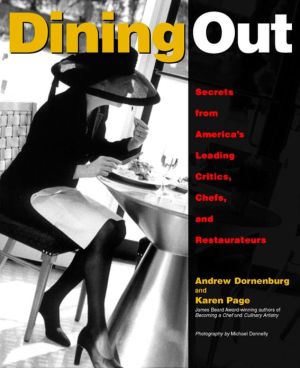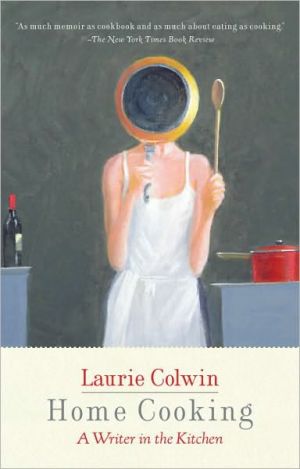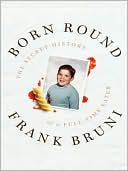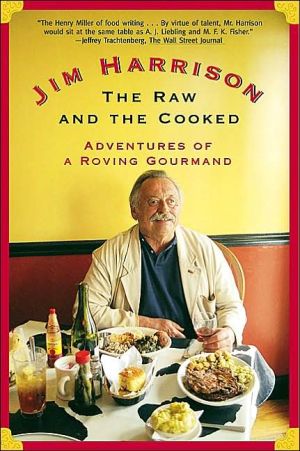Dining Out: Secrets From America's Leading Critics, Chefs, and Restaurateurs
This book is the first of its kind to examine what defines fine food in America and it introduces us to many individuals who shape our views about food. Using other successful Dornenburg/Page books as a model, the authors once again base their analysis on interviews with chefs, restaurateurs and critics. This insider's guide to the process of restaurant reviewing will excite anyone with a serious interest in food. It also features top sites on the Internet that provide restaurant reviews. 'If...
Search in google:
Dining Out Andrew Dornenburg and Karen Page "This book will enrich and enlighten anyone with an interest in dining out." —Patrick O’Connell, chef-owner, The Inn at Little Washington "The King of Spain is waiting in the bar, but your table is ready." —Sirio Maccioni of Le Cirque to New York Times restaurant critic Ruth Reichl "If you’ve invested $1.5 million in a project and certain people can crush you like a bug if they have a bad time, you’re a fool if you’re not trying to find out who these people are, what they look like, and when they’re in." —Bob Kinkead, chef-owner, Kinkead’s Just as food has become our national obsession, so has dining out virtually become its own sport. Dining enthusiasts, eager to get the take on new restaurants and the status of old favorites, look to restaurant critics and their discerning palates for guidance. So, who are these secretive personalities who often dine incognito and whose public judgments can make or break a restaurant or chef? Be a guest at their private table in Dining Out: Secrets from America’s Leading Critics, Chefs, and Restaurateurs, the first book to demystify the critical process and to unlock the secrets of a great restaurant experience. Drawing on extensive interviews and research, co-authors Andrew Dornenburg and Karen Page expose the wide-ranging experiences and insights of dozens of the most powerful palates in America, among them Gael Greene of New York, John Mariani of Esquire, Ruth Reichl of The New York Times, Phyllis Richman of The Washington Post, David Rosengarten and Caroline Bates of Gourmet, Patricia Unterman of The San Francisco Examiner, S. Irene Virbila of The Los Angeles Times, and Dennis Ray Wheaton of Chicago. They reveal their occasionally outlandish schemes for remaining anonymous—and what happens when their covers are blown! The critics also divulge how they review restaurants, what they think about the star system, and how they temper their personal biases when judging food, service, and ambiance. Then Dornenburg arid Page turn the tables, sharing the sentiments of well-known chefs and restaurateurs from across the country as they review the restaurant critics, from their credentials and rating systems to the forceful impact of their reviews. The chefs and owners of dozens of celebrated restaurants including Al Forno, Campanile, Chez Panisse, East Coast Grill, Fleur de Lys, Frontera Grill, Le Cirque 2000, Red Sage, and Stars offer their own definitions of excellence in food, service, and setting, and reflect on the role that the customer plays in the total dining experience. Special features of the book include:A guide to leading food critics’ favorite restaurants across AmericaRestaurant review resources available on the InternetAdvice from renowned sommeliers Larry Stone of Rubicon and Jean-Luc Le Dû of Daniel, and maître fromager Max McCalman of PicholineMusings by Pulitzer Prize-winning critics of architecture, media, and music on how they might approach restaurant criticismSpecial interviews with Danny Meyer on Providing Hospitality and Mark Miller on The Progress of American Gastronomy Dwight Garner In the food world, Nora Ephron has written, nothing is what it seems. "People who seem to be friends are not. People who admire each other call each other Old Lemonface and Cranky Craig behind backs. People who tell you they love Julia Child will add in the next breath that of course her husband is a Republican and her orange Bavarian cream recipe just doesn't work." Ephron wrote those words in 1968, but little has changed in the intervening 30 years. While spats between members of the food establishment draw headlines only rarely -- chef David Bouley's nasty break-up with business partner Warner LeRoy is the latest example -- knives are kept sharp in private. Gossip and intrigue are at a constant, rolling boil.Andrew Dornenburg and Karen Page's new book, Dining Out, promises to deliver the dish on the restaurant world circa 1998. The authors fanned out across the country, interviewing dozens of prominent critics (Ruth Reichl, Patricia Unterman), chefs (Alice Waters, Daniel Boulud) and owners (Danny Meyer, Sirio Maccioni), and they've returned with a book that's like a giant and slightly undercooked cassoulet -- the tasty bits are in there, but you've got to work to dig them out."Food has become our national obsession," the authors write, and thanks to the proliferating number of city magazines, web sites, Zagat guides and grungy 'zines, there's no escaping restaurant criticism -- everywhere you turn, somebody's pushing a steaming bowl of adjectives in your face. (Steve Forbes tosses in a few reviews at the close of his monthly columns; Consumer Reports now rates chain restaurants.) But as Dining Out makes clear, a handful of critics -- usually those at major daily newspapers -- continue to wield an almost monopolistic power. "The King of Spain is waiting in the bar," Le Cirque owner Maccioni is reported to have said to Times critic Reichl, "but your table is ready."Dining Out is crammed with anecdotes about critics' lives and methods, and about the lengths restaurants go to in order to spot them and, ideally, make them happy. Reichl talks about her outsize wig collection (she's the lady in black on Dining Out's cover, by the way), and the authors report that more than one restaurant has offered a reward to any employee who spots her at a table. Outside of New York, most critics say disguises aren't necessary. As long as you make the reservation under another name, and don't draw undue attention to yourself, there's little chance you'll be identified. Once a critic is spotted, Dornenburg and Page write, chefs leave little to chance -- most cook two versions of everything the reviewer has ordered, and bring out the most successful plate.Sometimes even that's not enough. Bad reviews happen, and a particularly negative one can put a restaurant out of business. San Francisco Chronicle critic Unterman has been threatened at knifepoint by a disgruntled chef; Houston Sidewalk's Alison Cook was once burned in effigy; the Philadelphia Inquirer's Elaine Tate has had rocks hurled through her windows. You may have noticed that all of the critics mentioned thus far are women; the authors note the current predominance of women in the field, as well as the odd fact that an unusually large number of food critics are both Jewish and musically inclined. Dornenburg and Page have an eye for this kind of stray detail. One sidebar is a list of the weirdest things critics have eaten. L.A. Weekly critic Jonathan Gold's weird list includes "braised goat penis" and, hopefully not in the same dish, "testicles of a bull that had fallen in the ring to the matador." As enjoyable as Dining Out can be to browse through, it's a chore to read cover to cover. In lieu of a shapely narrative, the authors appear to have simply dumped out the contents of their tape recorders. A typical section begins with a few breathless questions ("Is there anyone out there who hasn't, at some time or another, fantasized about being a restaurant critic? ... And is the reality of their jobs as wonderful as our illusions?") and ends with critic after critic giving opinions, often at numbing length. Worse is the authors' disinclination to jump into the fray themselves. Unlike Nora Ephron in her 1968 article on "The Food Establishment," Dornenburg and Page draw few conclusions and offer little in the way of synthesis. The pair bring fresh ingredients to the table; you're left wishing only that Dining Out weren't quite so al dente. -- Salon
PrefaceAcknowledgments1I Eat - Therefore, I Am12Who Is That Masked (Wo)Man?253Is Judging a Restaurant a Matter of Taste?534The Evolving Definition of "A Great Restaurant"955The Power of a Review1236Exploring the Art of Criticism1617The Customer: From "Caveat Emptor" to "The Golden Rule"1918Electing the Future of Dining223App. ASome of America's Leading Critics' Favorite Restaurants - And Why241App. BAn Internet Guide to Restaurant Review Resources305App. CBiographies of Those Interviewed327Index339
\ From Barnes & NobleThe Barnes & Noble Review\ Ever dreamed of becoming a restaurant critic? Or even just stepping into a food writer's shoes for a week or two? Then Dining Out will fascinate you. In this entertaining and informative book, the authors of Becoming a Chef and Culinary Artistry dish the real dirt on the world of restaurants and the writers who critique them. Andrew Dornenburg and Karen Page give the skinny on the power of restaurant critics to make or break an establishment and offer tips for having the best possible dining experience. — —Kate Murphy Zeman\ \ \ \ \ Dwight GarnerIn the food world, Nora Ephron has written, nothing is what it seems. "People who seem to be friends are not. People who admire each other call each other Old Lemonface and Cranky Craig behind backs. People who tell you they love Julia Child will add in the next breath that of course her husband is a Republican and her orange Bavarian cream recipe just doesn't work." Ephron wrote those words in 1968, but little has changed in the intervening 30 years. While spats between members of the food establishment draw headlines only rarely -- chef David Bouley's nasty break-up with business partner Warner LeRoy is the latest example -- knives are kept sharp in private. Gossip and intrigue are at a constant, rolling boil.\ Andrew Dornenburg and Karen Page's new book, Dining Out, promises to deliver the dish on the restaurant world circa 1998. The authors fanned out across the country, interviewing dozens of prominent critics (Ruth Reichl, Patricia Unterman), chefs (Alice Waters, Daniel Boulud) and owners (Danny Meyer, Sirio Maccioni), and they've returned with a book that's like a giant and slightly undercooked cassoulet -- the tasty bits are in there, but you've got to work to dig them out.\ "Food has become our national obsession," the authors write, and thanks to the proliferating number of city magazines, web sites, Zagat guides and grungy 'zines, there's no escaping restaurant criticism -- everywhere you turn, somebody's pushing a steaming bowl of adjectives in your face. (Steve Forbes tosses in a few reviews at the close of his monthly columns; Consumer Reports now rates chain restaurants.) But as Dining Out makes clear, a handful of critics -- usually those at major daily newspapers -- continue to wield an almost monopolistic power. "The King of Spain is waiting in the bar," Le Cirque owner Maccioni is reported to have said to Times critic Reichl, "but your table is ready."\ Dining Out is crammed with anecdotes about critics' lives and methods, and about the lengths restaurants go to in order to spot them and, ideally, make them happy. Reichl talks about her outsize wig collection (she's the lady in black on Dining Out's cover, by the way), and the authors report that more than one restaurant has offered a reward to any employee who spots her at a table. Outside of New York, most critics say disguises aren't necessary. As long as you make the reservation under another name, and don't draw undue attention to yourself, there's little chance you'll be identified. Once a critic is spotted, Dornenburg and Page write, chefs leave little to chance -- most cook two versions of everything the reviewer has ordered, and bring out the most successful plate.\ Sometimes even that's not enough. Bad reviews happen, and a particularly negative one can put a restaurant out of business. San Francisco Chronicle critic Unterman has been threatened at knifepoint by a disgruntled chef; Houston Sidewalk's Alison Cook was once burned in effigy; the Philadelphia Inquirer's Elaine Tate has had rocks hurled through her windows. You may have noticed that all of the critics mentioned thus far are women; the authors note the current predominance of women in the field, as well as the odd fact that an unusually large number of food critics are both Jewish and musically inclined. Dornenburg and Page have an eye for this kind of stray detail. One sidebar is a list of the weirdest things critics have eaten. L.A. Weekly critic Jonathan Gold's weird list includes "braised goat penis" and, hopefully not in the same dish, "testicles of a bull that had fallen in the ring to the matador."\ As enjoyable as Dining Out can be to browse through, it's a chore to read cover to cover. In lieu of a shapely narrative, the authors appear to have simply dumped out the contents of their tape recorders. A typical section begins with a few breathless questions ("Is there anyone out there who hasn't, at some time or another, fantasized about being a restaurant critic? ... And is the reality of their jobs as wonderful as our illusions?") and ends with critic after critic giving opinions, often at numbing length. Worse is the authors' disinclination to jump into the fray themselves. Unlike Nora Ephron in her 1968 article on "The Food Establishment," Dornenburg and Page draw few conclusions and offer little in the way of synthesis. The pair bring fresh ingredients to the table; you're left wishing only that Dining Out weren't quite so al dente. -- Salon\ \ \ \ Michael RuhlmanOffering insiders' knowledge and illuminating insights from some of the country's best chefs and food critics.\ — The New York Times Book Review\ \ \ \ \ Publishers WeeklyAnybody who has ever dreamed of joining a restaurant critic's inner circle will thoroughly enjoy this gossipy, insider's view by the 1996 winners of the James Beard Award for Best Writing on Food (Becoming a Chef). Interviews with leading critics and restaurateurs are a major part of the author's investigation into the methods employed by critics and the effect they have on restaurateurs' culinary ideals. It's a (relatively) serious topic, but one Dornenburg and Page address in a vibrant, conversational tone. Thanks to the unexpectedly dramatic lives of the characters involved, the pages buzz with often surprising tension, humor and emotion. Readers hear from restaurateurs who have staked fortunes on a creative vision, only to find that success often rests in the hands of a single, highly opinionated, sometimes unpredictable writer. The critics, meanwhile (most notably the New York Times's Ruth Reichl, teasingly shown on the cover wearing a face-obscuring hat), don wigs to maintain anonymity, fend off attacks from knife-wielding chefs and eat such dubious delicacies as braised goat penis and worms fried in lard. After being regaled with so many tart and entertaining observations, the final 100 service-oriented pages (Internet review sites, critics' favorite restaurants in selected cities) are somewhat anticlimactic. But just treat them like the after-dinner mint and the rest of the meal will get high marks for its appealing presentation, spice and color. 50 photos. (Oct.)\ \ \ \ \ Library JournalDornenburg and Page, coauthors of the award-winning Becoming a Chef (LJ 8/95) and Culinary Artistry (Van Nostrand Reinhold, 1996), move out of the kitchen and into the dining room, focusing on the restaurant critics whose opinions often determine where we dine on Friday night. While the authors demonstrate the same incisive culinary qualities as in their previous works, chapters and numerous sidebars on such topics such as "Cooking for Ruth Reichl" and spending a week in the restaurant lives of both Reichl and Gael Greene will hold little appeal for readers who aren't hard-core foodies. Mostly, the book presents food critics' comments about the review process as well as opinions from chefs and restaurateurs about the people who review them; like the Zagat guides, everyone gets to be a critic here. The book ends with a list of the top critics' favorite restaurants, a guide to restaurant review sources on the Internet, and biographies of interviewees, all fairly sugarcoated. Recommended only for specialized culinary collections due to some in-depth reporting and interviews with a few restaurant notables. Otherwise, "Where's the beef?"--Drew Ackers, New York\ \ \ \ \ Michael RuhlmanOffering insiders' knowledge and illuminating insights from some of the country's best chefs and food critics. -- The New York Times Book Review\ \








